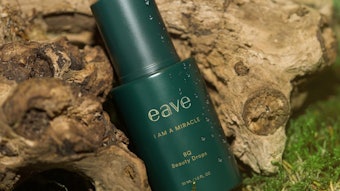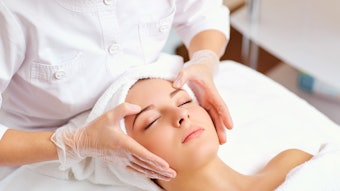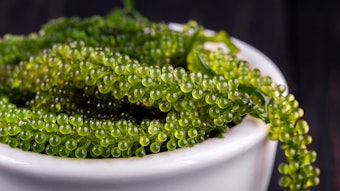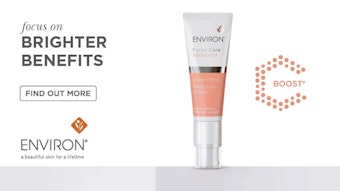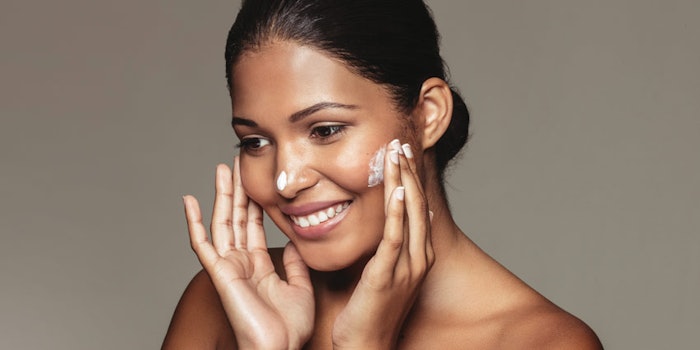
With the literal translation being “for life,” probiotics are viable non-pathogenic microorganisms able to impart numerous health benefits. The introduction of the term probiotic is attributed to IIya Metchnikoff, who won the Nobel Prize in physiology or medicine for his work in immunology along with Paul Erhlich in 1908. Today, use of probiotics inside and outside the body is at the forefront of health care.
Topical probiotics influence the skin’s microbiome, a collection of natural bacteria that live on the skin and help promote healthy skin cell function. In a nutshell, topical probiotics can help restore the balance of the skin, which can lead to visible reduction in redness and irritation and can also help the skin better resist free radical attack. This article will discuss the benefits of topical probiotics as well
as probiotic technologies on the horizon. First, however, it will dispell some myths surrounding topical probiotics.
Myth 1. All probiotics are the same.
Truth. The term probiotics refers to healthy bacteria. There are somewhere between 10 million to 1 billion different types of healthy bacteria on the planet. They can be found in soil, in water and over your entire body. With so many different types of bacteria existing, it seems fair to suggest that all probiotics are not the same. In fact, many different strains of healthy bacteria are presently used in supplements and treatments for numerous disease states from colitis and acne to irritable
bowel syndrome.
Myth 2. Topical probiotics are only for anti-aging.
Truth. Topical probiotics are used to help treat a multitude of skin disorders including rosacea, psoriasis, eczema, acne as well as premature wrinkling. In addition, topical probiotics are helpful in restoring the proper balance to the body’s microbiome that inhabit the body inside and out. The microbiome is disturbed by many factors, especially from the over-cleansing of the skin and the scrubbing that disrupts and destroys the health of the skin barrier.
Myth 3. Topical probiotics must be used in isolation.
Truth. Research has confirmed that topical probiotics are highly effective when used in conjunction with other treatment protocols. There are products available today that have been specifically created to integrate with existing menus and protocols and essentially improve the overall result of those existing treatments. While the future use of probiotics is bound to increase and perhaps there will be exclusive probiotic treatments available, it is perfectly proper to use topical probiotics as an inclusion to an established regimen.
Myth 4. All probiotics contain live bacteria.
Truth. When researchers began to study probiotics 30 years ago, they started with live bacteria. However, it quickly became apparent that there were too many variables and challenges in working with live bacteria in both topical applications and for use in supplements. Over the years, scientist have learned how to perfect the probiotic lysate (dead bacteria) and ensure it is as effective as live bacteria without the potential caveats of the latter. A fermentation process is used today that provides an optimal result.
Myth 5. Strain specificity is not important.
Truth. Quite the contrary, implementation of strain-specific bacteria is the absolute future of health and wellness on this planet. We have already discussed the vast numbers of potential healthy bacteria that exist all around us and even on us. Some of the good bacteria may be perfectly fine for use on a specific condition and yet create a new condition that requires treatment. We see this all the time with other medicinal ingredients. Continuing research has shown conclusive evidence that specific strains of probiotics will be used in the future to treat many disease states.
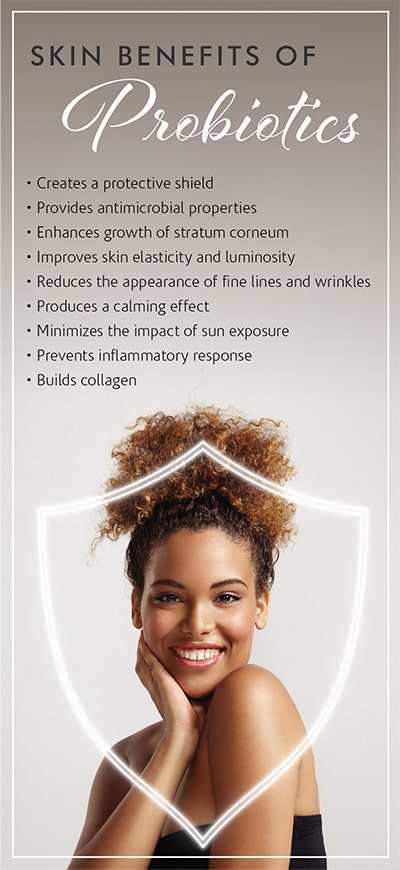
Topical Probiotics for Better Skin
Topical application of probiotics is relatively new, yet is quickly gaining popularity for its versatility and ability to restore balance to all skin types. Recently, probiotics have been documented to help improve atopic eczema and atopic dermatitis, heal burns and scars, rejuvenate skin and improve skin’s innate immunity. A study from 2016 on the anti-aging benefits of probiotics reveals they can: restore acidic skin pH, alleviate oxidative stress, reduce photoaging and improve skin barrier function.1 Documented benefits of probiotics are listed in Skin Benefits of Probiotics. In addition, the brightening, anti-wrinkle and antimicrobial benefits are discussed below.
Anti-wrinkle. Probiotics reduce the physical signs of aging by building collagen. In addition, they reduce the impact of sun exposure to reduce the appearance of fine lines and wrinkles. W.P. Bowe, one of the study’s authors, confirms this. “As we age, the pH of our skin rises and triggers certain enzymes in the skin to break down collagen, thereby accelerating the signs of aging,” she said. “We need probiotics that produce metabolites, such as lactic acid to bring that pH back down and slow the aging process.”
Antimicrobial. In patients with acne and rosacea, living microorganisms on the skin are recognized as foreign by the body’s immune system. The immune system springs into action to counter this potential threat, resulting in inflammation and redness. Topical probiotics prevent the skin cells from seeing the bad bacteria and parasites that can provoke an immune reaction—a process known as bacterial interference. Probiotics contain antimicrobials that kill bad bacteria. They also have a calming effect on acne flare-ups, preventing the immune system from sending “attack” messages that result in flares of acne or rosacea.
Brightening. Uneven skin tone and loss of a youthful glow are top skin care concerns. Probiotic products enhance and fortify the skin’s ability to do what it does naturally: renew and rejuvenate itself. The skin renewal processes are both accelerated and improved, promoting skin health.
Future Trends
Since skin treatment with probioticss is a relatively new concept, new ingredient technologies, product forms and trends utilizing them will continue to proliferate. On the horizon for probioics will be: fermentation, cleansers, patches and injectables, as discussed below.
Fermentation. Through the fermentation process, probiotic bacteria produce acidic compounds like lactic acid, reducing the pH of skin. Acidifying the skin discourages the growth of most pathogens favoring growth of resident flora. Skin microbiota controls the colonization of potentially pathogenic organisms, modulates immune response and skin barrier function, and is integral for skin health.
An example of fermented probiotics is lactococcus ferment lysate. This fermented probiotic positively influences both the speed and quality of epidermal growth, resulting in better barrier function and overall skin quality.
Cleansers. Cleansers containing probiotics will play a larger role in the overall protocols of skin care. There will be less water content in the cleansers of the future as they become more concentrated. They will also offer improved exfoliation while being more gentle on the skin barrier layer. I expect that cleansers will become more important as branded products, and certain brands will be utilized more by skin care professionals who will become educated in the new technologies. Probiotic cleansers will become popular with consumers because they will feel so much gentler when applied to the face.
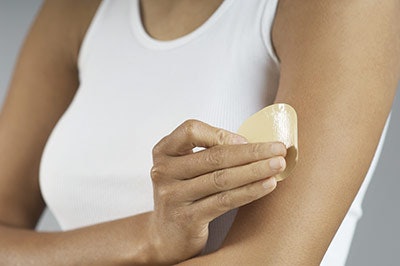
Patches. As with many technologies that have come before, the more we learn about the impact of probiotics on other body organs in addition to the skin, the greater role they will play in the entire wellness sector. We have already seen positive evidence in treatments of certain diseases of the skin from the use of probiotic patches. For example, 50 participating physicians are in the preliminary stages of development treating nearly atypical cells that could lead to melanoma with probiotic patches.
Injectables. There is growing evidence that probiotic technologies can be applied into further research and development, which may result in having the ability to develop treatments for disease states that are more effective, safer and less costly than present modalities. While still in the early stages of development, certain cancerous tumors have been attacked and eliminated by injecting certain bacteria into the affected cells, killing them without causing harm to the surrounding healthy cells.
Proof Positive
Undoubtedly, you will see more product manufacturers debut probiotic formulations in the coming years. If they peak your interest, it is wise to ask them if the products are clinically tested for safety and efficacy, produced in the United States and produced under strict current good manufacturing practices (cGMP*). If all of the information you receive checks out, incorporate probiotics into your client’s regimen.
Research into the potential applications of probiotics continues, and all of this research is proof positive that probiotics will play a much larger role in health and wellness over the coming years.
References



